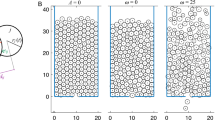Abstract
The rheological properties of a leukocyte significantly affect its biological and mechanical characteristics. To date, existing physical models of leukocyte are not capable of quantitatively explaining the wide range of deformation and recovery behaviors observed in experiment. However, a compound drop model has gained some success. In the present work, we investigate the effect of nucleus size and position, and the relative rheological properties of cytoplasm and nucleus, on cell recovery dynamics. Two nucleus sizes corresponding to that of neutrophil and lymphocyte are considered. Direct comparison between numerical simulations and experimental observation is made. Results indicate that the time scale ratio between the nucleus and cytoplasm plays an important role in cell recovery characteristics. Comparable time scales between the two cell components yield favorable agreement in recovery rates between numerical and experimental observations; disparate time scales, on the other hand, result in recovery behavior and cell shapes inconsistent with experiments. Furthermore, it is found that the nucleus eccentricity exhibits minimum influence on all major aspects of the cell recovery characteristics. The present work offers additional evidence in support of the compound cell model for predicting the rheological behavior of leukocytes. © 1999 Biomedical Engineering Society.
PAC99: 8717-d, 8719Tt
Similar content being viewed by others
REFERENCES
Bagge, U., and P.-I. Branemark. White blood cell rheology: An intravital study in man. Adv. Microcirc. 7:18–28, 1977.
Bagge, U., R. Skalak, and R. Attefors. Granulocyte rheology. Adv. Microcirc. 7:29–48, 1977.
Dong, C., R. Skalak, and K.-L. P. Sung. Cytoplasmic rheology of passive neutrophils. Biorheology 28:557–567, 1991.
English, D., and B. R. Andersen. Single-step separation of red blood cells, granulocytes, and mononuclear leukocytes on discontinuous density gradients of Ficoll-Hypaque. J. Immunol. Methods 5:249–252, 1974.
Evans, E. A., and B. Kukan. Passive material behavior of granulocytes based on large deformation and recovery after deformation tests. Blood 64:1028–1035, 1984.
Kan, H.-C., H. S. Udaykumar, W. Shyy, and R. Tran-Son-Tay. Hydrodynamics of a compound drop with application to leukocyte modeling. Phys. Fluids 10:760–774, 1998.
Moazzam, F., F. A. DeLano, Zweifach, and G. W. Schmid-Schonbein. The leukocyte responses to fluid stress. Proc. Natl. Acad. Sci. USA 94:5338–5343, 1997.
S. V. Patankar. Numerical Heat Transfer and Fluid Flow. Washington, DC: Hemisphere, 1980.
Peskin, C. S. Numerical analysis of blood flow in the heart. J. Comput. Phys. 25:220–252, 1977.
Schmid-Schonbein, G. W., Y. Y. Shih, and S. Chien. Morphometry of human leukocytes. Blood 56:886–875, 1980.
Shyy, W., Computational Modelling for Fluid Flow and Interfacial Transport. Amsterdam: Elsevier, 1994.
Shyy, W., H. S. Udaykumar, M. M. Rao, and R. W. Smith. Computational Fluid Dynamics with Moving Boundaries. Washington, DC: Taylor & Francis, 1996.
Skierczynski, B. A., S. Usami, S. Chen, and R. Skalak. Active motion of polymorphonuclear leukocytes in response to chemoattractant in a micropipette. J. Biomech. Eng. 115:503–509, 1993.
Tran-Son-Tay, R., D. Needham, A. Yeung, and R. M. Hochmuth. Time-dependent recovery of passive neutrophils after large deformation. Biophys. J. 60:856–866, 1991.
Tran-Son-Tay, R., H. P. Ting-Beall, D. V. Zhelev, and R. M. Hochmuth. Viscous behavior of leukocytes. In: Cell Mechanics and Cellular Engineering, edited by V. C. Mow, F. Guilak, R. Tran-Son-Tay, and R. M. Hochmuth. New York: Springer, 1994.
Tran-Son-Tay, R., H.-C. Kan, H. S. Udaykumar, E. Damay, and W. Shyy. Rheological modeling of leukocytes. Med. Biol. Eng. Comput. 36:246–250, 1998.
Tsai, M. A., R. E. Waugh, and P. C. Keng. Passive mechanical behavior of human neutrophils: effects of colchicine and paclitaxel. Biophys. J. 74:3282–3291, 1998.
Udaykumar, H. S., H.-C. Kan, W. Shyy, and R. Tran-Son-Tay. Multiphase dynamics in arbitrary geometries on fixed cartesian grids. J. Comput. Phys. 137:366–405, 1997.
Usami, S., S.-L. Wung, B. A. Skierczynski, R. Skalak, and S. Chen. Locomotion forces generated by a polymorphonuclear leukocyte. Biophys. J. 63:1663–1666, 1992.
P. Vigneron. Effect of Nucleus on Leukocyte Deformation. University of Florida, Master Thesis, 1998.
Zhelev, D. V., and R. M. Hochmuth. Human neutrophils under mechanical stress. In: Cell Mechanics and Cellular Engineering, edited by V. C. Mow, F. Guilak, R. Tran-Son-Tay, and R. M. Hochmuth. New York: Springer, 1994.
Author information
Authors and Affiliations
Rights and permissions
About this article
Cite this article
Kan, HC., Shyy, W., Udaykumar, H.S. et al. Effects of Nucleus on Leukocyte Recovery. Annals of Biomedical Engineering 27, 648–655 (1999). https://doi.org/10.1114/1.214
Issue Date:
DOI: https://doi.org/10.1114/1.214




